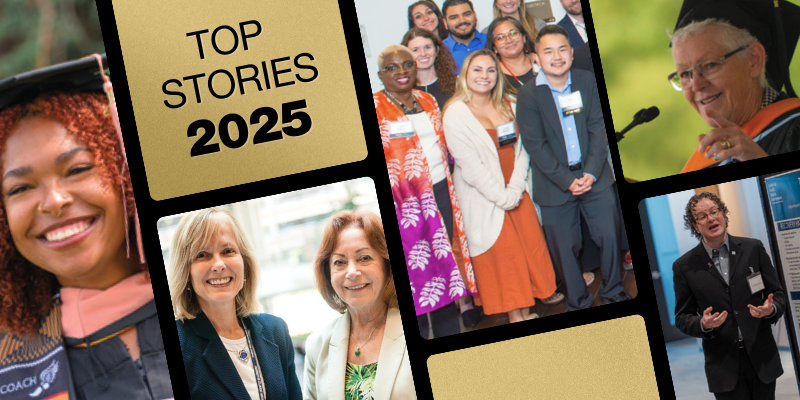Irina Kasarskis entered Ohio State University with no declared major but a vague sense she wanted to find a path in medical care or health sciences.
Then a door unexpectedly swung open. The university offered a class billed as an introduction to the health professions. The aim was to help those undecided students like Kasarskis sharpen their career focus. Professionals from different health care sectors came in to describe their work to students. When the public health group began their one-week turn, Kasarskis says she knew nothing about the field, but their brief stay had an outsized effect on her.
“They talked about how they worked on an outbreak of tuberculosis,” Kasarskis recalls. “And I thought that sounds like a really fun problem to solve. I left thinking that is totally what I want to do.”
Forging an independent path
At that time, Ohio State didn’t have an undergraduate public health program, but Kasarskis was not deterred. She created her own major, completing a variety of internships with professors in the school’s College of Public Health. Drawn to what she saw as the diversity of the public health field, she mixed in coursework in epidemiology, sociology, psychology, anthropology, and statistics.
“Public health has a nice balance for people who like to change and pivot, based on what is going on in society,” Kasarskis says.
Kasarskis has maintained that balance during more than a decade of work in epidemiology, with a focus on infectious disease. She will mark the latest stage of her public health career on May 19 as she completes her Doctor of Public Health (DrPH) degree from the Colorado School of Public Health and serves as convocation speaker on the University of Colorado Anschutz Medical Campus.
Exploring pieces of the public health puzzle
The DrPH degree and speaking honor are testaments to Kasarskis’s commitment to probing the complexities of public health. After earning her Master of Public Health at Boston University, she worked for six years as an epidemiologist for the State of Oregon. The job was split, with one half devoted to reporting data on publicly funded tests and the other half to managing surveillance data for three nationally notifiable conditions.
The work gave her a close look at “how public health works at the state level.” She saw how data gets reported and moved to the national level and how funding for public programs benefit people and strive to meet their health care needs.
She also saw that her job as an epidemiologist fits into the broader puzzle of administering public health services.
“I learned a lot about how Medicaid services work,” Kasarskis says. “I saw challenges patients face around stable housing and accessing medications.”
A wider view of the health care world
In short, the work in Oregon broadened her perspective, Kasarskis says. She gained “a more holistic view” of the health care system.
“A unique aspect that I really appreciated was working with people who were not epidemiologists but really understood how to build relationships with community members,” Kasarskis says. “I learned the benefit of multidisciplinary collaboration to tackle a problem.”
The more she learned in her job, the greater the hunger she felt to advance her skills in epidemiology. In particular, she wanted to boost her communication, leadership, and management skills. An opportunity came with an evaluation and training program offered through a partnership between the CDC and the Rocky Mountain Public Health Training Center at ColoradoSPH.
At the time, Oregon was confronting an increase in cases of congenital diseases. Kasarskis and a colleague signed up for the program in order to find ways to address the problem. The program led to Kasarskis’s decision to consider ColoradoSPH to pursue her DrPH.
“It ended up being a great fit,” she says.
A great opportunity during a time of crisis
She entered her DrPH program at perhaps the most challenging time imaginable – in the middle of the COVID-19 pandemic. Kasarskis viewed the crisis as an opportunity to simultaneously broaden her skills and help society.
“I really wanted to have some role in the COVID response,” she says. Fortuitously, ColoradoSPH had started a COVID-19 Modeling Group, a multidisciplinary group formed to help the state control the disease. “I lucked out in that they had an opening when I started out as a student, and they asked me to join,” Kasarskis recalls.
She worked on designing ways to translate data and disease modeling into “digestible information” for state leadership, including Governor Jared Polis and local health officials.
“It was a crash course in learning how to translate data for people making policy decisions,” Kasarskis says. “I feel fortunate that I was in the right place at the right time when I applied to the school.”
“Irina was someone we could count on to take a complicated set of data and turn it into an elegant figure that we could share with state leadership and the media, often on very tight deadlines,” says Dr. Elizabeth Carlton, chair of the Department of Environmental and Occupational Health, who led the COVID-19 modeling team with former Colorado School dean Dr. Jon Samet.
The work was also another opportunity to learn from experts in different disciplines – environmental and occupational health, sociology, mathematics, and software systems, among others – and work with complex data and analytical tools. The goal: make what was happening during the pandemic understandable.
COVID spawns questions about measuring hospital capacity
Her work with the COVID-19 Modeling Group motivated her DrPH dissertation, which evaluated the public health surveillance systems in Colorado and how its performance impacts infectious disease forecasting of hospital capacity for COVID-19 and respiratory syncytial virus (RSV).
“How long did it take data, from the time a person was diagnosed, to actually get into the system where you could count that person?” Kasarskis said.
Delays in that process impact the health care system’s ability to forecast hospital capacity and therefore the power to make the most accurate decisions possible about allocating resources, she explained.
“That’s why I spend a lot of time thinking about how our public health surveillance system works and the limitations of our system in making decisions,” Kasarskis said.
With the convocation approaching, Kasarskis said she plans to talk about recent “dramatic changes” in public health and the importance of building partnerships with community members to build their trust and to help spread credible information about ways to protect themselves from disease and other threats.
“I think we can all work towards improving population health,” she said. “That’s where I am gravitating, is towards collaboration, community, and communicating.”



.jpg)

%20(2).png)
